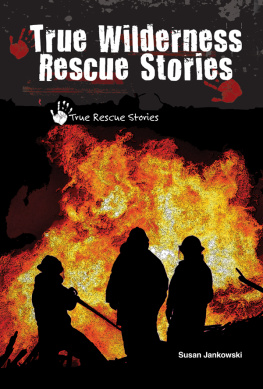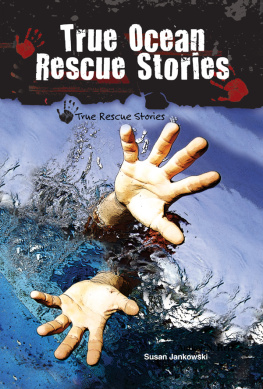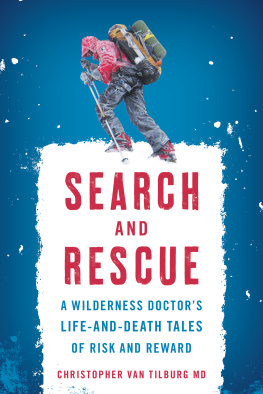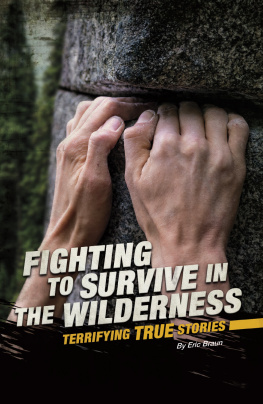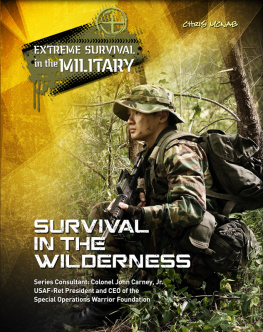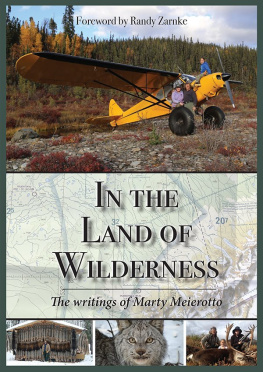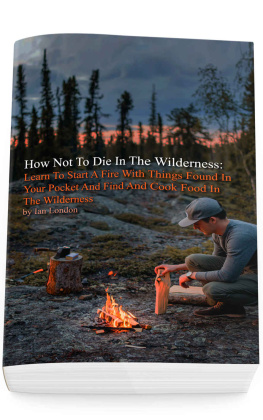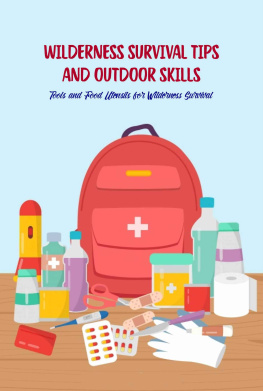Susan Jankowski - True Wilderness Rescue Stories
Here you can read online Susan Jankowski - True Wilderness Rescue Stories full text of the book (entire story) in english for free. Download pdf and epub, get meaning, cover and reviews about this ebook. year: 2011, publisher: Enslow Publishers, genre: Art. Description of the work, (preface) as well as reviews are available. Best literature library LitArk.com created for fans of good reading and offers a wide selection of genres:
Romance novel
Science fiction
Adventure
Detective
Science
History
Home and family
Prose
Art
Politics
Computer
Non-fiction
Religion
Business
Children
Humor
Choose a favorite category and find really read worthwhile books. Enjoy immersion in the world of imagination, feel the emotions of the characters or learn something new for yourself, make an fascinating discovery.
- Book:True Wilderness Rescue Stories
- Author:
- Publisher:Enslow Publishers
- Genre:
- Year:2011
- Rating:4 / 5
- Favourites:Add to favourites
- Your mark:
- 80
- 1
- 2
- 3
- 4
- 5
True Wilderness Rescue Stories: summary, description and annotation
We offer to read an annotation, description, summary or preface (depends on what the author of the book "True Wilderness Rescue Stories" wrote himself). If you haven't found the necessary information about the book — write in the comments, we will try to find it.
Many people go into the wilderness as a way to escape from their daily lives. But sometimes what starts out as a fun trip can turn into a harrowing story of danger. Read about thrilling rescues that took place in the wild, such as how a person was saved from a burning forest fire, and how a group of friends was rescued by their dog. Sidebars include tips on how to thrive in the wilderness.
True Wilderness Rescue Stories — read online for free the complete book (whole text) full work
Below is the text of the book, divided by pages. System saving the place of the last page read, allows you to conveniently read the book "True Wilderness Rescue Stories" online for free, without having to search again every time where you left off. Put a bookmark, and you can go to the page where you finished reading at any time.
Font size:
Interval:
Bookmark:
WHEN THINGS GO WRONG IN THE WILD
Many people go into the wilderness as a way to escape from their daily lives. But sometimes what starts out as a fun trip can turn into a harrowing story of danger. Read about thrilling rescues in the wild, such as how a person was saved from a burning forest fire, and how a group of friends was rescued by their dog. Fact boxes include tips on how to thrive in the wilderness.
About the Author
Susan Jankowski is a writer, journalist, and educator. She is also a licensed falconer who participates in raptor research studies in Washington State.

- Aluminum is an element that does not easily catch fire or burn. Its melting point is 1220.6 degrees Farenheit (660.37 degrees Celsisus). Because of its ability to withstand intense heat, aluminum is used to make airplanes and firefighting equipment.
- Nurse Clara Barton founded the American Red Cross in 1881 as the nations first disaster relief organization. Today it also helps people in trouble in small communities.
- The Appalachian Trail was completed in 1937. It is a hiking trail that runs north-to-south through the mountains, forests, and pastures of the eastern United States.
- Experts prevent big avalanches by setting off small bombs to cause smaller ones. Natural avalanches can move snow over 100 miles per hour. Each year, 150 people die from being buried in avalanches. (For this reason, it is very important to stay on marked hiking trails during the winter and spring seasons.)
- Conifers are trees that bear cones and keep their leaves (or needles) year round. They are known as evergreen trees for this reason. The fir, pine, spruce, and cedars of Americas forests are all coniferous trees.
- The magnetic needle on a compass always points north.
- Fiberglass is the name of a product made from glass spun into a kind of yarn.
- Medivac is the transport of a person to a place where he or she can get medical treatment. Medivac helicopters are often used in mountain and forest rescues. This is because it is the fastest way to transport a patient to a hospital, which may be many miles away.
- In the past twenty-five years, thirty-five people have died trying to reach the summit of Mount Hood in Oregon.
- The U.S. Army retired mules, donkeys, and horses from service in the middle of the twentieth century. Today, soldiers in Afghanistan are finding donkeys and mules useful in the mountains for hauling supplies and weapons.
- The Federal Emergency Management Agency (FEMA) has a national certification program for search and rescue dogs and also for their handlers.
- Water repellant clothing is made when the fabric is coated with rubber or plastic that is baked into the material.
A careless camper left a fire to smolder in Washington States Okanogan-Wenatchee National Forest in 2001. It didnt take long for a few hot embers to turn into a thirty-mile blaze. It has gone down in history as The Thirtymile Fire.
Rachel Welch and a crew of twenty other firefighters from the U.S. Forest Services Naches Ranger District rushed to the scene. They began fighting the fire the way they had been trained. They dug a line around the edges of the blaze to keep it from spreading. At first, it seemed like the firefighters had the fire under control in a canyon by the Chewuch River in the northern Cascade Mountains.
But things had been tricky earlier that day. Squad leader Tom Craven checked around the fire line. He saw the fire was crowningspreading from treetop to treetop. Tom ordered his crew to pack up its gear and cross the river to get away from the flames.
Once on the other side, everyone felt safe. The crew ate lunch. Rachel even took a short nap. Then they returned to work to pump water and dig out a fire line in other areas.
Suddenly, Tom, who was known for his smile and cheerful ways, turned very serious. Twelve years of experience helped him learn to sense when a fire was about to become dangerous.
Its time to get out right now, ordered Tom. Then he said it again.
The huge fire was quickly spreading over the ridge of the canyon. It was coming up the road right toward the crew.
You could see it on the road. It was just like a huge, big flame. Thats all you could see was fire, Rachel later told news reporters. She and other crew members jumped into their vans and drove off to an area they thought was a safe zone.
Once on the other side of the canyon, Rachel and the other crew members returned to work fighting the fire. But she soon heard shoutsand orders to find shelter. Suddenly, flames were everywhere!
It was raining embers, Welch said. It was like the sound of a freight train. It was roaring. It was eating things up!
Crew members scattered. Some ran for Forest Service vans; others to a sandbar; and a few others towards the road. They hurried to set up shelters. Tom and a few others ran to a field of boulders.
Rachel, just twenty-two, knew what to do. She got into her special tent-like blanket made out of aluminum and fiberglass. Once inside, she would have a better chance of surviving the flames.
Then Welch heard calls for help. Two campers, Bruce and Paula Hagemeyer, called out to her.
Help us! Help uswe have to get into your tent! they begged her.
Even though the tent was made for only one person, Rachel shared it with the Hagemeyers. Somehow the three of them squeezed together so they would all fit inside. Rachel became the leader of the three. She ordered Paula and Bruce to hold still and try not to rip the tent as the flames burned over them. This truly was a matter of life and death.
After what seemed like a long time, they heard someone calling to them to get into the river. The three jumped out the tent and ran for the water.
After the biggest flames had passed, only nine of the fourteen firefighters walked out into the road. One crew member was badly burned and had to be carried out from the charred land.
Tom Craven and three of the other firefighters never returned from the wilderness. Like Rachel, they had set up their blanket shelters. But they were in the field of boulders. They perished because the air inside their shelters had become super-heated among the rocks.
By the time the fire was extinguished, even Rachel had second-degree burns on her right side. But she and the two campers had survived the raging flames. According to Deputy Forest Service Chief Jim Furnish, Paula and Bruce Hagemeyer would have likely died without Rachels help.
Rachel was among those firefighters who became a hero on that hot, dry, July day. The fire burned 9,500 acres of the Okanogan-Wenatchee National Forest in north-central Washington. It was one of the deadliest fires in the states history.
The U.S. Forest Service set up a memorial northeast of the town of Winthrop to honor the four firefighters who died trying to put out the flames. Three of them, two women and one man, were under twenty-one years-old; they had been looking forward to their futures. Squad leader Tom Craven had been the oldest. He was only thirty years old.
Their deaths greatly upset the people of Washington State. People wondered whether fire commanders could have done more to protect the firefighters at the scene. They pointed out that many of the crew members were rookies. This means crew members were young and new to firefighting. People demanded the Forest Service investigate what went wrong during the fire to cause their deaths.
Years of arguments followed among firefighters, government lawmakers, and citizens in a United States court of justice. Some accused the crews commander of failing to do his job. He was also charged with not being truthful about what happened when investigators asked him questions about the fire.
Font size:
Interval:
Bookmark:
Similar books «True Wilderness Rescue Stories»
Look at similar books to True Wilderness Rescue Stories. We have selected literature similar in name and meaning in the hope of providing readers with more options to find new, interesting, not yet read works.
Discussion, reviews of the book True Wilderness Rescue Stories and just readers' own opinions. Leave your comments, write what you think about the work, its meaning or the main characters. Specify what exactly you liked and what you didn't like, and why you think so.

